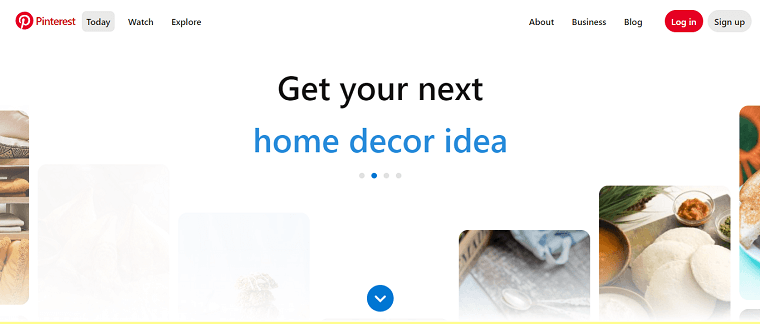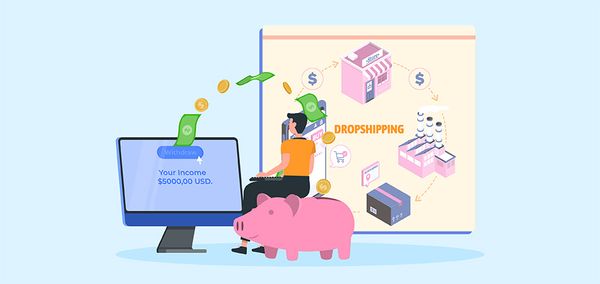Strategies for Earning Income through Affiliate Marketing on Pinterest

42.2% of affiliate marketers utilize Pinterest as a means to drive traffic and promote products. In today's digital landscape, affiliate marketing stands out as one of the most lucrative methods to earn money online by recommending products and earning commissions upon purchases. But did you know that using platforms like Pinterest can make affiliate marketing even more successful? In this comprehensive guide, we'll delve into the world of affiliate marketing on Pinterest, uncovering strategies, tips, and tricks to help you harness the platform's potential and pave the way for a steady stream of income.
What Is Pinterest

Pinterest is a social media platform where people discover and save ideas for things they love, want to try or need. It is a place where people find and save ideas for things they like or want to try. It's like a huge bulletin board where you can share pictures and links. It's like a virtual pinboard where users can collect and organize images and links related to their interests. Users can create boards for different topics, such as recipes, home decor, fashion, travel, and more. They can then save "Pins," which are images or videos with links attached, to these boards. Pinterest is known for its visually appealing interface and its ability to inspire creativity and exploration. With millions of users worldwide, Pinterest serves as a hub for discovering new trends, products, and ideas across various categories.
Why Do Affiliate Marketing With Pinterest
Pinterest presents numerous benefits for individuals seeking to monetize their online presence through affiliate marketing, making it an appealing option with a range of advantages. Let's explore some key reasons why affiliate marketing on Pinterest can be a game-changer:
1. Targeted Audience
One of the primary reasons to choose affiliate marketing on Pinterest is the platform's highly targeted audience. Pinterest users are actively seeking inspiration and solutions for their interests and needs. Whether it's finding recipes, planning home decor projects, or discovering fashion trends, users turn to Pinterest with specific intentions in mind. This focused mindset makes them more receptive to product recommendations, making it easier to convert clicks into sales.
2. Visual Appeal
Pinterest is inherently visual, with users scrolling through a visually stimulating feed of images and videos. This emphasis on visuals makes it an ideal platform for showcasing products and driving engagement. Affiliate marketers can leverage this visual appeal to create compelling pins that catch the eye and entice users to click through to learn more about the products being promoted. By incorporating high-quality images and videos into their affiliate marketing strategy, marketers can increase the likelihood of driving conversions and earning commissions.
3. Evergreen Content
Unlike other social media platforms where content can quickly get buried in users' feeds, Pins on Pinterest have a longer lifespan. Pinterest's algorithm prioritizes content based on relevance and quality, meaning that well-crafted Pins can continue to drive traffic and generate sales long after they've been published. This evergreen nature of Pinterest content is particularly advantageous for affiliate marketers, as it allows them to reap the rewards of their efforts over time.
4. Large User Base
With over 400 million monthly active users, Pinterest boasts a vast and diverse user base spanning various demographics and interests. This large user base presents ample opportunities for affiliate marketers to reach their target audience and promote relevant products and services. Whether you're targeting millennial home decorators, fitness enthusiasts, or DIY enthusiasts, chances are you'll find them on Pinterest. By tapping into this expansive user base, affiliate marketers can maximize their reach and increase their earning potential.
How to Use Pinterest for Affiliate Marketing
Affiliate marketing on Pinterest can be a highly effective way to generate income, but success hinges on strategic planning and execution. Here's a step-by-step guide on how to harness the power of Pinterest for affiliate marketing:
1. Select Your Niche
The first step in affiliate marketing on Pinterest is to choose a niche that aligns with your interests, expertise, and the interests of your target audience. Your niche should be specific enough to stand out in the crowded Pinterest landscape but broad enough to attract a sizable audience. Conduct research to identify trending topics, popular categories, and areas with high demand but relatively low competition. Whether it's fashion, home decor, fitness, or personal finance, selecting the right niche is crucial for long-term success in affiliate marketing on Pinterest.
2. Set Up Your Account
Once you've chosen your niche, it's time to create or optimize your Pinterest account for affiliate marketing. If you don't already have one, sign up for a Pinterest business account, as it provides access to valuable analytics and advertising features. Optimize your profile by using relevant keywords in your username, bio, and board descriptions to improve discoverability. Customize your profile by uploading a professional profile picture and creating branded board covers that reflect your niche and style. Additionally, enable Rich Pins for your website to provide additional context and information about your affiliate products directly on Pinterest.

|
Adapt Your Product Prices Automatically DSers Automatic Pricing - Pre-set Pricing Rule to mark-up your product price automatically |
3. Define Affiliate Programs
Next, research and identify affiliate programs relevant to your niche and audience. Look for reputable programs that offer competitive commissions, high-quality products or services, and reliable tracking and reporting. Many brands and retailers offer affiliate programs that cater to specific niches, so take the time to explore your options and choose programs that align with your content and audience. Once you've selected your affiliate programs, sign up and familiarize yourself with the program's terms and conditions, commission structure, and promotional guidelines.
4. Create and Share Affiliate Links
With your affiliate programs in place, it's time to start creating and sharing affiliate links on Pinterest. Identify products or services that resonate with your audience and have the potential to drive conversions. Use tools provided by your affiliate programs to generate unique tracking links for each product or service you wish to promote. Incorporate these affiliate links into visually compelling pins that showcase the benefits and features of the products or services you're promoting. Craft engaging pin descriptions that provide additional context and encourage users to click through to learn more or make a purchase.
5. Grow Your Traffic
The final step in affiliate marketing on Pinterest is to grow your traffic and maximize your earning potential. Focus on increasing the visibility of your pins by actively engaging with the Pinterest community. Join relevant group boards and participate in niche-related communities to expand your reach and connect with like-minded users. Pin consistently and strategically, scheduling pins at optimal times for maximum exposure. Monitor the performance of your pins using Pinterest Analytics and adjust your strategy accordingly to capitalize on what's working and improve what's not. Additionally, consider leveraging other marketing channels such as email marketing, social media, and blogging to drive traffic to your Pinterest profile and increase your affiliate sales.
Tips for Affiliate Marketing on Pinterest
To maximize your success in affiliate marketing on Pinterest, it's essential to employ effective strategies and techniques. Here are some valuable tips to help you optimize your affiliate marketing efforts on Pinterest:
Tip 1: Optimize for SEO
Optimizing your pins for search engines is crucial for increasing their visibility and driving organic traffic to your affiliate links. Incorporate relevant keywords in your pin titles, descriptions, and image alt text to improve your chances of appearing in Pinterest search results. Conduct keyword research to identify popular search terms and trends in your niche, and use them strategically in your pin content to attract your target audience.
Tip 2: Enable Rich Pins
Rich Pins provide additional context and information about your pins, making them more informative and engaging for users. Enable Rich Pins for your website to automatically display metadata such as product prices, descriptions, and availability alongside your pins. This extra information helps users make informed decisions and increases the likelihood of them clicking through to your affiliate links. Rich Pins also lend credibility to your content, enhancing trust and confidence among your audience.
Tip 3: Schedule Pins in Advance
Consistency is key to maintaining a strong presence on Pinterest and maximizing your affiliate marketing potential. You can use scheduling tools such as Tailwind or Buffer to arrange and plan your pins in advance. This allows you to maintain a steady flow of content without having to manually pin each item every day. Schedule your pins to be published during peak times when your target audience is most active to ensure maximum visibility and engagement.
Tip 4: Analyze Pin Performance
Regularly monitor the performance of your pins using Pinterest Analytics to gain insights into what's working and what's not. Pay attention to metrics such as impressions, clicks, saves, and engagement rates to identify top-performing pins and trends in your content. Analyze the types of pins, topics, and formats that resonate most with your audience and replicate their success in future content. Use this data to refine your strategy, optimize your pins, and focus your efforts on activities that drive the most significant results.
Tip 5: Build an Email List
Building an email list is a powerful way to nurture relationships with your audience and promote your affiliate products more effectively. Offer valuable content or incentives, such as free guides, exclusive discounts, or access to members-only content, in exchange for email subscriptions. Once you've built a list of engaged subscribers, regularly communicate with them via email to provide valuable insights, recommendations, and promotions. Incorporate affiliate links strategically into your email content to drive conversions and generate affiliate income.
EndNote
Affiliate marketing on Pinterest presents a wealth of opportunities for individuals looking to monetize their online presence. By implementing the tips and strategies outlined in this guide, you can harness the power of Pinterest's visual platform, engaged user base, and advanced features to drive traffic, increase conversions, and generate passive income through affiliate marketing. Remember to stay consistent, monitor your performance, and adapt your approach based on insights and feedback. With dedication, creativity, and strategic planning, you can unlock the full potential of affiliate marketing on Pinterest and pave the way for sustained success in the ever-evolving landscape of online marketing.
Want to find more information? Visit DSers blog.












 Company
Company
 Why Choose DSers
Why Choose DSers
 Blog
Blog
 Help Center
Help Center




 Live Chat
Live Chat